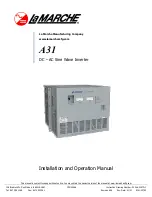
Aquair 100
TM
Manual
© Ampair
®
, 2007
www.ampair.com
Page 16 of 23
Installation of charge control regulator
Make sure the generator is not operating whilst connecting to the regulator. Connecting with live wires
can damage the electronic regulation circuit.
At initial start-up, allow a time of 1-2 minutes for circuit timing functions to become active.
Protecting the system:
Fuse warning - never omit fuses, simple in-line fuse carriers may be used, they protect your system
from excessive battery currents in the event of a serious electrical fault. If they keep blowing, find out
why.
Fuses = l0A for 12V systems; 5A for 24V systems.
The regulators are internally protected by SAE fuses, which are not substitutes for battery protection
fuses. The fuses must be next to the battery terminals since, in the event of a fault, the batteries would
source the fault current. Check and double-check polarities before making connections, insert the fuses
in the fuse carriers last of all.
Corrosion:
This is the enemy of all electrical connections, especially in marine environments. Site regulators in a
weather proof location, as dry as possible, and splash proof. Inspect all terminations and connections
for signs of corrosion. Rectify by cleaning, remaking etc. Use tinned copper wire for extension leads to
prevent corrosion spreading inside cable insulation.
Operating problems:
A digital multi-meter is useful for checking operational faults, if no permanent monitoring instruments
are used. Battery voltage levels and those of the charging source can be read directly. Charging current
readings will require the multi-meter to be installed in line. In this way currents into and out of the
regulator can be observed. Do not remove battery connections since regulator operation depends on a
very small supply current. If the regulator is suspect then it can be temporarily bypassed by connecting
the source positive direct to a battery positive. The negative connections are common and do not need
disturbing unless regulator replacement is necessary. Use the multi-meter continuity range to confirm
all cable runs are low resistance.
Operation:
When installed, the generator and regulator will run and maintain the batteries automatically. The unit
may be run in conjunction with any other charge-source with no known interactive problems. Regular
battery inspection and topping up must still be carried out to obtain maximum battery life.
Faulty regulator:
Each regulator is individually tested and a chart recording kept of its operation. Each regulator has a
unique serial number and a test date. Please provide these with any queries. If the regulator is suspect,
then it can be temporarily bypassed i.e. connect the rectifiers directly to the battery terminals observing
correct polarity. If this reinstates correct charging, then the regulator must be serviced or replaced.
Regulators draw a small current (typically 1mA at 12V) from the battery to activate the sense and
control circuits.
Without this connection the regulator will be inoperative.
SERVICING.
If the regulator is suspect, then it can be temporarily by passed i.e. connect the generator directly to the
battery terminals observing correct polarity. If this reinstates correct charging, then the regulator must
be serviced or replaced. Regulators draw a small current (typically 1mA at 12v) from the battery to
activate the sense and control circuits. Without this connection the regulator will be inoperative.








































